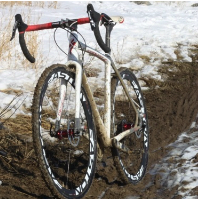Riding in the Dirt! Cyclocross for your Off Season!
It is the end of triathlon race season and you are just not quite ready to start living on your trainer. You’ve noticed more and more Cyclocross articles pop up on your newsfeed and perhaps you want to explore something new.
Cyclocross began in Europe and has been around for almost as long as people have been road riding. For many years it enabled road racers to maintain fitness and sharpen their bike handling skills in the off season. It turns out that Cyclocross is a perfect sport to keep you outside and on the bike well into the fall and early part of December. One of the chief benefits of learning this dirty sport is in developing your bike handling skills. During the course of a race you will need to take sharp and often wet corners, make and navigate the water/ feeding station, ride shoulder to shoulder with fellow competitors, and deal with unpredictable and unfriendly surfaces. Negotiating corners, hills, bad weather and potholes will be a breeze with the new skills that you will develop during Cyclocross. This winter skills ‘workshop’ will give you more confidence next season on those fast descents and sharp corners on the race course.
A Cyclocross bike should be the same geometry as your road bike but you can make a few small adjustments. In order to give more stability over rougher terrain you can raise the stem stack 3mm and shorten your stem by about 10 millimetres. Replace your road pedals and shoes for mountain bike equipment to make running through the mud and up hills easier with more traction. Finally, optimal gearing is in the range of 46-36 for front and in the rear a 11-28 or 11-30, to account for short steep ascents over soft ground.
Cyclocross season in Canada spans from September to the beginning of December. Races are held on a closed course about 2-3km in length. Each race site is set up differently and all have their own interesting challenges: natural obstacles such as fallen trees, sharp turns, mud (on rainy days, lots of it!), short hills, man-made hurdles, sand pits and stairs. Each race lasts 40 to 60 min, requiring you to work in or just below your aerobic threshold zone.
Training tips
Spend some training time being specific about Cyclocross racing demands. Look for riding routes that have obstacle which help with skill development such as dismounting, remounting, and cornering on soft ground, shouldering your bike and short steep hills that you have to run up. Practise each one of these skills over and over at a slow speed and then increase slowly tell you can do each one at race speed.
Some things to incorporate into your training program.
Bike: 5 min Zone 4 (Aerobic threshold) with 1 min recovery Zone 2 x 4-8 intervals.
Run: Hill repeats of 4 min Zone 4 with 1 min recovery Zone 2 x 3-6. Repeats
Stairs: Find stairs that will give you an effort up to 1-2 min Zone 4-5 with 30-40 sec recovery Zone 2 x 5-8 repeats. This can also be done on a stair machine.
Race Day Tips:
· Arrive early on Race day: If you arrive 1.5 hrs before the first race goes off then you have time to walk the course and make note of all obstacles, hidden holes, tree roots and rocks that you may not see on the bike.
· Pre ride the course slowly at first picking the fastest line around or over each obstacle and increasing your speed each lap.
· Make note of shift points on the course so you can preselect your gear that you will need to keep your momentum going.
· Make note of dismount and remount points at those obstacles that are faster to run up or over.
· Endeavour to improve your skills with each lap.
· Lastly have fun and enjoy!
Cyclocross is a great late season way to race for fun. You will keep running and riding in a novel environment and lay down some great confidence for your next season!
Video Links:
1. Introduction
2. Dismounting
3. Cornering
5. Shouldering
LifeSport coach Mark Overton has coached for over 25 years. Mark has extensive experience helping athletes at the beginner to intermediate level in taking the next step to achieving their goals and dreams. Contact Mark to share your goals, race faster, or master the Ironman distance.
